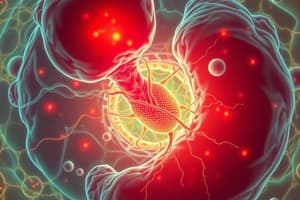Podcast
Questions and Answers
What is a characteristic clinical presentation of granulosa-theca cell tumors in postmenopausal women?
What is a characteristic clinical presentation of granulosa-theca cell tumors in postmenopausal women?
- Precocious puberty
- Hirsutism and virilization
- Pleural effusions and ascites
- Endometrial hyperplasia with postmenopausal uterine bleeding (correct)
What distinguishes a Krukenberg tumor from primary ovarian mucinous carcinoma?
What distinguishes a Krukenberg tumor from primary ovarian mucinous carcinoma?
- Unilateral involvement of the ovary
- Presence of Reinke crystals
- Bilateral involvement of both ovaries (correct)
- Production of estrogen
Which tumor is primarily associated with hirsutism and virilization due to androgen production?
Which tumor is primarily associated with hirsutism and virilization due to androgen production?
- Granulosa-theca cell tumor
- Krukenberg tumor
- Fibroma
- Sertoli-Leydig cell tumor (correct)
Which of the following statements regarding fibromas is incorrect?
Which of the following statements regarding fibromas is incorrect?
What is the main cause behind pseudomyxoma peritonei?
What is the main cause behind pseudomyxoma peritonei?
Flashcards
Sex cord-stromal tumors
Sex cord-stromal tumors
Tumor that resembles sex cord-stromal tissues of the ovary.
Granulosa-theca cell tumor
Granulosa-theca cell tumor
A tumor that grows from granulosa and theca cells, often producing estrogen. It can cause symptoms depending on the age of the patient.
Sertoli-Leydig cell tumor
Sertoli-Leydig cell tumor
A tumor composed of Sertoli cells that form tubules and Leydig cells with characteristic Reinke crystals. This tumor can produce androgens, leading to hirsutism and virilization.
Fibroma
Fibroma
Signup and view all the flashcards
Krukenberg tumor
Krukenberg tumor
Signup and view all the flashcards
Study Notes
Sex Cord-Stromal Tumors
- Tumors resembling sex cord-stromal tissues of the ovary
- Granulosa-theca cell tumor
- Neoplastic proliferation of granulosa and theca cells
- Often produces estrogen, causing signs of estrogen excess
- Precocious puberty before puberty
- Menorrhagia or metrorrhagia during reproductive years
- Endometrial hyperplasia with postmenopausal uterine bleeding after menopause (most common in this setting)
- Malignant, but low risk of metastasis
- Sertoli-Leydig cell tumor
- Composed of Sertoli cells forming tubules and Leydig cells between tubules
- Contains characteristic Reinke crystals
- May produce androgen, associated with hirsutism and virilization
- Fibroma
- Benign tumor of fibroblasts
- Associated with pleural effusions and ascites (Meigs syndrome)
- Symptoms resolve with tumor removal
Metastasis
- Krukenberg tumor
- Metastatic mucinous tumor affecting both ovaries
- Usually from a diffuse type of metastatic gastric carcinoma (most cases)
- Bilaterality helps distinguish this from a primary ovarian mucinous carcinoma (which is typically unilateral)
- Pseudomyxoma peritonei
- Massive accumulation of mucus in the peritoneum
- Typically due to a mucinous tumor of the appendix, often with metastasis to the ovary
Studying That Suits You
Use AI to generate personalized quizzes and flashcards to suit your learning preferences.
Related Documents
Description
Explore the various types of sex cord-stromal tumors, including Granulosa-theca cell tumors and Sertoli-Leydig cell tumors. Understand their characteristics, symptoms, and potential complications such as metastatic spread. This quiz offers insights into diagnosis and treatment options for these tumors.




